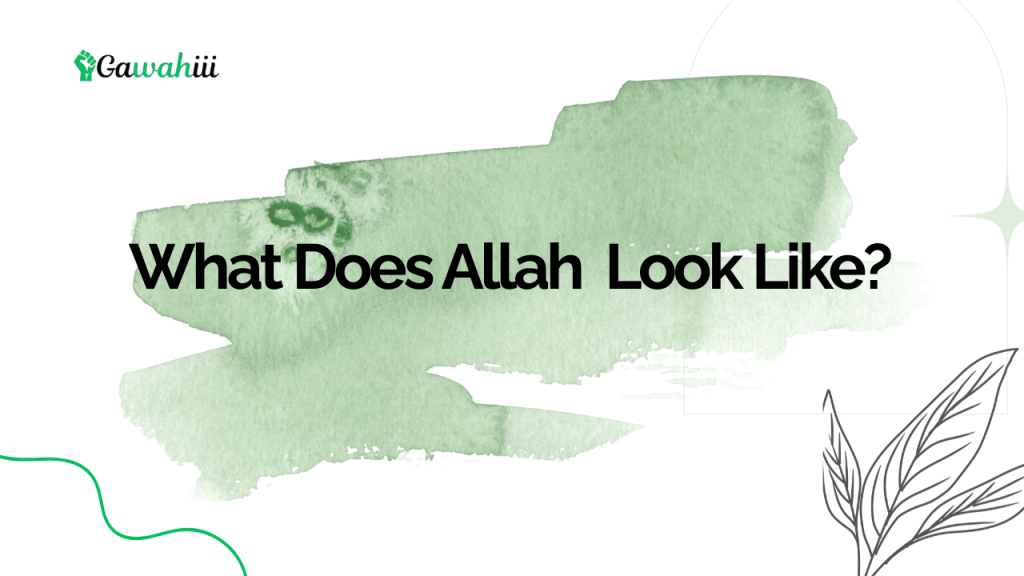Introduction
what does allah look like Now that people always ask questions and use images in discussion, people—including Muslims and non-Muslims—often ask: “What is Allah’s appearance?” It shows an interest in the divine, particularly because our world is full of imagery and symbols. Even so, in the belief system of Islam, Allah is not limited to how Allah can look or be depicted.
The author investigates this question by looking at the Qur’an, Hadith and earlier Islamic literature. We want to clear up popular wrong beliefs about Allah, explain that He does not have a human form and describe how Muslims connect to Him. Curious outsiders or dedicated Muslims can both benefit from this piece which shares clarifying and genuine Islamic information.
We should understand what is really behind the question—what Allah looks like—and how the answer is much deeper than it might first seem.
Tawheed means knowing that Allah is one and only.
Muslims believe in Tawheed which means that Allah exists fully alone and without equals. Because of this idea, Muslims come to view Allah in specific ways.
Key principles:
- Allah is different from everything else: Surah Ash-Shura (42:11) tells us, “Nothing is like Him.”
- There are no pictures: Islam does not permit making any image of Allah.
- Transcendence: Allah cannot be found inside the limits of space, time or stuff.
The reason this is important:
- Helps people avoid idolatry (shirk) and associations that are not true with God.
- Keeps worship focused only on the Creator and not on any images made by people.
- It ensures Spiritual well-being and clear thinking about beliefs.
- Allah cannot be compared to anything we know or can think of which proves His greatness and divinity.
What Is the Reason for Islam Preventing Any Art that Portrays Allah
Many religions show gods having traits from both humans and animals. However, Islam absolutely forbids artists from making these kinds of images.
What led to the prohibition:
- Not rejecting the fact that there is only One God (Tawheed).
- Preventing anthropomorphism, in which human qualities are added to Allah.
- Protecting people from idol worship which was very common before Islam emerged.
Historical context:
- Intentionally avoiding it, early Islamic communities did not portray any of their prophets to avoid deification.
- Spiritual link is the main message in the Qur’an and Hadith, not artistic images.
Common misconceptions:
- Some people believe mistakenly that Islam is against representing Allah’s image. It really emphasizes that Allah cannot be represented by images.
- differential from most mythologies, where deities have a body or physical appearance.
Quranic verses that Talk About Allah
The Qur’an gives detailed descriptions of Allah’s attributes, concentrating on who He is rather than how He look
Examples of divine attributes:
- Al-Basir means ‘The All-Seeing’.
- Al-Sami‘ – The One who is able to hear all sounds.
- Ar-Rahman – The Most Merciful
- The word Al-Quddus means The Most Pure.
- “His presence can’t be imagined, yet His vision touches every plan and idea.” (Surah Al-An’am 6:103)
Key takeaways:
- There is no detailed picture of Allah’s form given in the Qur’an.
- The emphasis is placed on His names and features which explain how He engages with creation.
| Attribute | Meaning | Significance for Believers |
|---|---|---|
| Al-Hayy | The Ever-Living | Allah never dies or sleeps |
| Al-Qadir | The All-Powerful | Allah has control over all things |
| Al-‘Aleem | The All-Knowing | Allah’s knowledge is infinite |
How Hadith Helps Explain the Meaning of the Divine
Although the Qur’an gives us revelations from God, the Hadith explains the way the Prophet Muhammad approached the idea of seeing God.
Key Hadiths:
Prophet Muhammad ﷺ stated: “You will get to see your Lord as you see the moon in its clear state.” (Sahih al-Bukhari).
It describes the final Judgment, not an earthly representation and underlines that clarity is more important than physical detail.
Scholarly explanation:
- People’s understanding and experience of Allah in the Afterlife are said to be limitless and unmatched, claim experts.
- The experience may not appear in your sight but will be felt and remembered in a spiritual way.
What Is the Question “What Does Allah Look Like?” Mistakes the Meaning
Asking the question may show a lack of understanding about who Allah is.
Why the question creates issues:
- The idea comes across as if Allah had a shape which goes contrary to Islamic teaching.
- Supposes the Creator can be explained by using the language of the creation.
A more effective way:
- Make inquiries like: What distinguishes Allah? and How should I practice my religion to be nearer to Allah?
- Bear in mind, God does not require that we rely on how things look but rather on faith, discipline and education.
- Allah’s identity is recognized by His signs, names and merciful actions and not by anything physical.
The Religious View of the Paradise Experience, by the Experts
Allah states in Islamic teachings that those who are just will see Him after their death. So what does this actually say?
Key concepts:
- This is supported in the Qur’an, where we read: “Some of the faces will shine with happiness, trying to look upon their Lord above that Day.” (Al-Qiyamah 75:22–23)
- Spiritual and given by God, not present in the physical world.
Scholarly consensus:
- It will appear as something true and direct, though unlike created images.
- Those in Paradise will find it is the most rewarding thing for them.
Investigating religious traditions beyond one’s own to see how God is represented.
Studying how other religions view God lets us recognize the special beliefs of Islam.
| Religion | View of God’s Form | Islam’s View |
|---|---|---|
| Christianity | Often depicted as an old man (art/icons) | Allah has no image or likeness |
| Hinduism | Multiple gods with forms/avatars | Islam: One unseen God, no intermediaries |
| Judaism | Strict monotheism; some visual depictions in history | Similar to Islam in concept of formlessness |
Islam’s uniqueness:
- They hold on to basic monotheism—they do not make images and use no intermediaries.
- The divine names revealed by Allah are how believers worship Him and not through images.
Effects on the Mind and Beliefs
- What is the result when a believer worships a God who takes no shape or form?
- Some positive influences of spirituality:
- Permits people to devote themselves fully to the faith.
- Helps users depend on skills instead of how something looks.
- Keeps people from getting distracted or falsely informed.
Psychological benefits:
- Decreases any uncertainty about who is the Creator and who is the creation.
- Makes the mental focus more on an internal sense of unity than on outside images.
- Worship starts to feel special, significant, and inspired spiritually.
Clarifying the Common Confusions and Mistakes About Allah
Misinformation can be spread rapidly because of the internet. We should look into some typical mistakes.
Comparing Stories to True Facts:
- A lot of people think of Allah as a wise old man sitting up in the sky.
- Allah exists in all moments, past, present and future and in all spaces.
The story: Muslims are not sure who they should worship. - Muslims worship God, knowing God’s names and special characteristics.
Misconception: Muslim followers are held back from knowing what Allah looks like.
Tawheed is maintained by understanding spiritual reality.
Ways Muslims Find to Connect with Allah Despite Not Being Able to Witness Him
While Allah is not seen, Muslims form a close relationship with Him by
Traffic management tools to use:
- Worship with prayer (Salah) five times each day.
- Du’a (Supplication): Personal communication with Allah.
- Read the Qur’an: Be able to understand what Allah is saying without someone’s explanation.
- To Contemplate (Tafakkur): Pondering the events and creatures around us, remembering Allah.
The result:
- Feeling close to Allah without even seeing Him.
- A person whose mind is aware of Allah’s size because of His creation.
FAQs
Do Muslims ever have the chance to see Allah?
Yes, those who are righteous will get to see Allah, which is higher and more wonderful than anything their minds could ever grasp.
For what reason is the picture of Allah forbidden in Islam?
To protect the uniqueness of Allah and not represent Allah as a person or an object.
Do any of the Muslim scriptures talk about Allah’s appearance?
No. According to the Qur’an and authentic Hadith, Islam talks about His attributes, but not His form.
How do Muslims think about Allah’s presence if He is not visible?
Signs, attributes, and the effects of His will are found in all aspects of the universe.
Do the beliefs about Allah have resemblances to the gods in different religions?
Philosophically, Allah has no similarity to any other idea. He is unlike other gods in the ways he is shown and described.
Conclusion:
People often think about what Allah appears to be in this question. It is an opportunity to learn more about theology, but it does not answer the question physically. Islam states that Allah is not understood by humans and has no equal, and He is perfect in every way. Instead of imagining God, Muslims try to understand and follow Him by His words, seek out His will, and love Him from the heart.
It keeps the pure idea of one God and, at the same time, helps people reach out to Him. Anyone seeking Islam or truth should know: it is greater to experience Allah through faith than to try and see Him.
- Also read this:
- part







